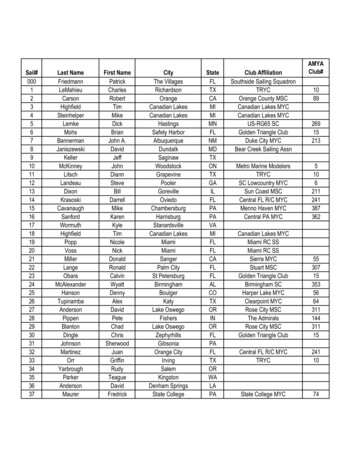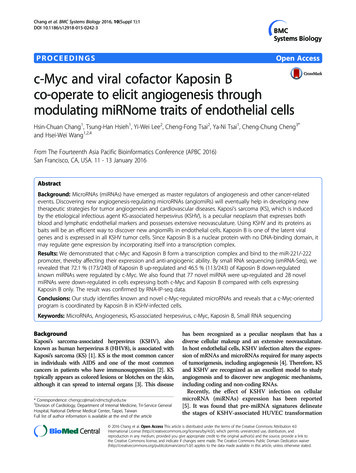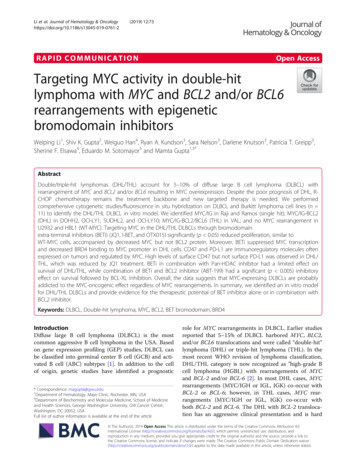
Transcription
OPENOncogene (2017) 36, 5231–5242www.nature.com/oncORIGINAL ARTICLENovel MYC-driven medulloblastoma models from multipleembryonic cerebellar cellsD Kawauchi1,2, RJ Ogg3, L Liu1, DJH Shih4, D Finkelstein5, BL Murphy1, JE Rehg6, A Korshunov7, C Calabrese8, F Zindy1, T Phoenix9,Y Kawaguchi10, J Gronych11, RJ Gilbertson9, P Lichter11, A Gajjar12, M Kool2, PA Northcott9, SM Pfister2,13 and MF Roussel1Group3 medulloblastoma (MBG3) that predominantly occur in young children are usually associated with MYC amplification and/oroverexpression, frequent metastasis and a dismal prognosis. Physiologically relevant MBG3 models are currently lacking, makinginferences related to their cellular origin thus far limited. Using in utero electroporation, we here report that MBG3 mouse modelscan be developed in situ from different multipotent embryonic cerebellar progenitor cells via conditional expression of Myc andloss of Trp53 function in several Cre driver mouse lines. The Blbp-Cre driver that targets embryonic neural progenitors inducedtumors exhibiting a large-cell/anaplastic histopathology adjacent to the fourth ventricle, recapitulating human MBG3. Enforcedco-expression of luciferase together with Myc and a dominant-negative form of Trp53 revealed that GABAergic neuronalprogenitors as well as cerebellar granule cells give rise to MBG3 with their distinct growth kinetics. Cross-species gene expressionanalysis revealed that these novel MBG3 models shared molecular characteristics with human MBG3, irrespective of their cellularorigin. We here developed MBG3 mouse models in their physiological environment and we show that oncogenic insults drive thisMB subgroup in different cerebellar lineages rather than in a specific cell of origin.Oncogene (2017) 36, 5231–5242; doi:10.1038/onc.2017.110; published online 15 May 2017INTRODUCTIONMedulloblastoma (MB), a malignant embryonal brain tumor with apeak incidence in childhood, exhibits considerable molecularheterogeneity with the existence of at least four distinctsubgroups—Wingless (WNT), Sonic Hedgehog (SHH), Group3(G3) and Group4 (G4).1,2 These subgroups have distinct characteristics with respect to age, gender, prognosis and response totherapy.3 The genetic and phenotypic differences of MBsubgroups are in part attributable to differences in their cellularorigin.4 Identification of the cellular origin of a tumor often relieson the molecular characterization of normal and tumor tissues;however, tumor-specific somatic alterations likely confound suchanalysis. Thus, the generation of genetically engineered animalsbearing tumors arisen under physiological conditions provides acontext for investigating oncogenic events underlying thetransformation of a normal cell into a tumor cell in vivo.Spatial and temporal specification of cell fate within thecerebellum is well characterized,5 and has been integral to theidentification of molecular signatures associated with cerebellarneuronal subtypes along the spectrum of neurogenesis.6 Theseneuronal lineages provide a means to assess the effect of geneticmodifications (e.g. activation of oncogenes and deletion of tumorsuppressor genes) on a specific neuronal sub-population, and thusto develop genetically engineered MB mouse models.7 A number1of studies have uncovered distinct cells of origin for MBsubgroups: genetic ablation of Ptch1 enables descendants ofcerebellar stem cells (e.g. granule neuron precursors (GNPs) andNestin-positive ( ) cells) to form SHH MBs (MBSHH),8–10 whereasexpression of a constitutively active mutant form of Ctnnb1 indorsal hindbrain progenitors, generates WNT MBs (MBWNT).11 Incontrast, forced activation of WNT signaling in GNPs impairs theirproliferation and induces differentiation,12–14 which highlights thedifferences in cancer susceptibility among neural progenitorsunder the influence of the same oncogenic insult. Enforcedexpression of MYCN under the glutamate transporter 1 (Glt1)promoter or in neonatal cells positive for the glial fibrillary acidicprotein (GFAP ) induces MBs with high expression of Kcna1, aknown marker of G4 MBs (MBG4),15 whereas MYCN overexpressionin Trp53-null GNPs or embryonic cerebellar stem cells triggersMBSHH.15–17 These studies demonstrate that genetic insults tospecific cerebellar cell types can influence the subgroup-specificcharacteristics of MBs.MYC-driven MBs are mainly classified as G3 (MBG3) andrepresent one of the most aggressive subgroup.2,3 They arecharacterized by frequent metastasis at diagnosis and are oftenassociated with a dismal outcome.18 So far, several orthotopicmodels of MYC-driven MBG3 were developed in mice by Myc andTrp53 dysregulation.12,16,19 We and another group independentlyDepartment of Tumor Cell Biology, St Jude Children’s Research Hospital (SJCRH), Memphis, TN, USA; 2Division of Pediatric Neuro-Oncology, German Cancer Research Centre(DKFZ), Heidelberg, Germany; 3Department of Radiological Sciences, St Jude Children’s Research Hospital (SJCRH), Memphis, TN, USA; 4The Hospital for Sick Children, Peter GilganCentre for Research and Learning, Toronto, ON, Canada; 5Department of Computational Biology, St Jude Children’s Research Hospital (SJCRH), Memphis, TN, USA; 6Department ofVeterinary Pathology Core, St Jude Children’s Research Hospital (SJCRH), Memphis, TN, USA; 7Clinical Cooperation Unit Neuropathology, German Cancer Research Centre (DKFZ),Department of Neuropathology, University of Heidelberg, Heidelberg, Germany; 8Department of Small Animal Imaging Core, St Jude Children’s Research Hospital (SJCRH),Memphis, TN, USA; 9Department of Developmental Neurobiology, St Jude Children’s Research Hospital (SJCRH), Memphis, TN, USA; 10Department of Clinical Application, Centerfor iPS Cell Research and Application, Kyoto University, Kyoto, Japan; 11Department of Molecular Genetics, German Cancer Research Center (DKFZ), Heidelberg, Germany;12Department of Oncology, St Jude Children’s Research Hospital (SJCRH), Memphis, TN, USA and 13Department of Pediatric Hematology and Oncology, Heidelberg UniversityHospital, Heidelberg, Germany. Correspondence: Dr D Kawauchi, Division of Pediatric Neuro-Oncology, German Cancer Research Center (DKFZ), Im Neuenheimer Feld 280,Heidelberg 69120, Germany or Professor MF Roussel, Department of Tumor Cell Biology, St Jude Children’s Research Hospital, 262 Danny Thomas Place, Memphis, TN 38105, USA.E-mail: d.kawauchi@dkfz.de or martine.roussel@stjude.orgReceived 4 December 2016; revised 22 February 2017; accepted 12 March 2017; published online 15 May 2017
MYC-driven medulloblastoma from embryonic progenitorsD Kawauchi et al5232reported the first orthotopic mouse model of MBG3 by overexpressing Myc in combination with functional loss of Trp53 inpostnatal cerebellar cells selected by fluorescence-activatedcell sorting for the basic helix–loop–helix transcription factorAtoh1-positive (Atoh1 ) and Prominin/CD133-positive (Prom1 )cells.12,16 Nevertheless, while human MBG3 have been found inOncogene (2017) 5231 – 5242relatively young children,20 the role of Myc expression intransforming embryonic stem/progenitors into malignant cellsunder physiological conditions has not yet been tested. We herereport the first MBG3 model from embryonic cerebellar cells byMyc activation and loss of Trp53 function using in uteroelectroporation (EP)-based in vivo gene transfer combined to a
MYC-driven medulloblastoma from embryonic progenitorsD Kawauchi et alCre/LoxP-mediated technology. The present study also providesthe opportunity to trace tumor growth with bioluminescence andfluorescent proteins, which will help in the future to not onlyunderstand cellular and molecular mechanisms of tumorigenesisbut also to undertake further preclinical trials.RESULTSEP of embryonic cerebellar neuroepithelium with Myc andTrp53DN induces MBG3Human MBG3 is typically restricted to infants and youngerchildren,20 prompting us to assess the predisposition of embryonic cerebellar progenitors to initiate MBG3. Previous orthotopicMBG3 models from postnatal progenitors required loss of Trp53function to overcome cell death caused by excess Mycexpression.12 Consistent with these results, the oncogenictranscriptional repressor growth factor independent 1, known toantagonize Trp53,21 was subsequently shown to cooperate withMyc to induce MBG3 in an orthotopic transplant model.22 Indeed,MYC-TP53 dysfunction has been reported in relapsed humanMBG3.23 We reasoned that we could use Myc expression and adominant-negative form of Trp53 to model MBG3 using embryoniccells. In vivo EP of plasmids into mouse embryos is an effectivemethod to transfer genes into cerebellar progenitors underphysiological conditions.11,24 To avoid dilution of plasmid-drivengene expression as cells divide, we used the Tol2 transposonmediated genomic integration system.25 We constructed two Tol2cis-flanked CAG promoter-driven plasmids: Tol2-CAG-LoxP-DsRed2LoxP (LRL)-Myc-IRES-Luciferase (Luc)-Tol2 (pT2K LRL-Myc-IRES-Luc)that strongly express both Myc and Luc after excision of the LRLcassette in the presence of the Cre recombinase protein(Figures 1a and b) and Tol2-CAG-Trp53DN-copGFP-Tol2, encodinga dominant-negative form of Trp53 (Trp53DN)26 fused to a T2Apeptide with arthropod-derived green fluorescent protein(copGFP) (pT2K Trp53DN-copGFP). To target broadly cerebellarneural stem/progenitor cells, as the first step these plasmids wereelectroporated into brain lipid-binding protein (Blbp)-Cre-IRESnuclear localized LacZ (nlacZ) embryos at embryonic (E) day 13.5together with the Tol2 transposase (T2TP)-carrying plasmid(pCAGGS T2TP) that lacks Tol2 cis elements to prevent multiplegene ‘hopping’ (Figure 1c). At E13.5, Cre expression was restrictedto the cerebellar ventricular zone (VZ) and the external granulelayer (EGL), the two germinal zones of the cerebellum(Supplementary Figures 1a and b′). Lineage tracing analysis in[Blbp-Cre-IRES-nlacZ; R26-LSL-EYFP] mice identified broadly distributed enhanced yellow fluorescence protein-positive (EYFP ) cellsat P7 (Supplementary Figures 1c and d). While Calb1 Purkinjecells lack EYFP (Supplementary Figure 1e), the great majority ofcerebellar cells, including inhibitory cerebellar interneuron progenitors (Pax2 ), granule cells (Pax6 ) as well as Bergmann gliaand multipotent progenitors (Sox2 ), expressed EYFP(Supplementary Figures 1f–h). We electroporated the LRL-EGFPgene27 into the cerebellar neuroepithelium of [Blbp-Cre-IRES-nlacZ]embryos by EP at E13.5 to confirm that Cre-mediated recombination of transfected plasmids occurred in vivo. Two days after EP(E15.5), most of the labeled cells expressed enhanced greenfluorescent protein (EGFP) rather than DsRed2 (SupplementaryFigures 1i and j), which is consistent with the distribution ofCre cells revealed by X-gal staining (Supplementary Figure 1k).We also observed a small population of EGFP cells in the choroidplexus (CP) (Supplementary Figure 1j). Immunohistochemistry(IHC) revealed successful recombination of the transfected geneswithin Pax6 cells in the EGL, Sox2 cells in the VZ and Pax2 cellsmigrating inwards deep into the cerebellum (SupplementaryFigures 1l–n).We next performed in utero EP of LRL-Myc-IRES-Luc and T2TPwith or without Trp53DN-copGFP in [Blbp-Cre-IRES-nlacZ] embryosat E13.5 and subsequently monitored Luc activation in neonatalmice by in vivo bioluminescence. Strong Luc signal was detectedin the head of Cre-carrying, but not wild-type (Cre-negative) mice(Figure 1d). In the absence of Trp53DN-copGFP, the bioluminescence signal disappeared by 5 weeks after birth and no MBsdeveloped within 5 months after birth (n 6, SupplementaryFigure 2a). These data indicate that overexpression of Myc aloneis insufficient to induce MBs in vivo. Intriguingly, in one out of sixcases, a CP carcinoma (CPC) was induced by Myc overexpression inthe absence of Trp53 loss (Supplementary Figure 2b), which isconsistent with the activation of EGFP expression downstreamof LRL in electroporated CP cells (Supplementary Figure 1j). Incontrast, triple EP of LRL-Myc-IRES-Luc, Trp53DN-copGFP and T2TPresulted in cerebellar tumors with 100% penetrance. Luc signalsincreased steadily (Figure 1e) and all mice were killed within8 weeks of birth due to progressive tumor burden (Figure 1f). Sixout of 14 mice developed only CPCs in the fourth ventricle(Supplementary Figures 2b–d and Table 1). All the other tumorswere diagnosed as MBs with large-cell anaplastic characteristics(hereafter called Blbp-MYC MB) (Figures 1e–h). Tumors werehighly proliferative (Ki67 ) with MBG3 characteristics, namely Npr3expression (Figures 1i and j). Importantly, tumor cells stronglyexpressed copGFP (Figure 1k), indicating that Trp53 inactivation isa prerequisite of MBG3 formation. EP-induced Blbp-MYC MBs alsoshowed strong expression of known stem cell marker genes(Figure 1l). These tumors displayed gene expression profiles forthe most part different from Myc-driven CPCs; however, somegenes were shared with MBG3 (e.g. Npr3) (Supplementary Figures2e and f). Hematoxylin and eosin (H&E)-stained sections confirmedleptomeningeal metastasis of the tumors (Supplementary Figures3a and b). The luciferase signal expanded from the hindbrain tothe cerebral cortex as tumors developed, invading the olfactorybulb (Supplementary Figures 3c–h), implying a high tendency ofBlbp-MYC MBs for metastatic dissemination as reported for humanMBG3.1 No tumors developed without Myc overexpression(Figure 1f), excluding the possibility that Blbp-MYC MBs wereaccidentally caused by transposition of Tol2-flanked transgenes,Figure 1. Generation of MBG3 using in utero EP-based gene transfer approach. (a) Schematic representation of conditional transcriptionalactivation of Myc and Luc in the presence of the Cre recombinase. (b) Immunoblotting with antibodies against Myc and Luc of protein lysatesfrom HEK293T cells untransfected (lane 1) or transfected with Myc-IRES-Luc (lane 2) or LRL-Myc-IRES-Luc with (lane 3) or without (lane 4) the Creexpression vector. Note: Luc expression is regulated downstream of the internal ribosomal entry site (IRES) and expressed at low levels in theabsence of Cre. (c) Schematic representation of a sagittal section of embryonic hindbrain at E13.5, when in utero EP was performed. Cre wasexpressed in the EGL and VZ of [Blbp-Cre-IRES-nlacZ] mice. Plasmid DNAs were injected into the fourth ventricle and transfected into cells bydelivering electric pulses through the ventricule/hindbrain. (d) Bioluminescence imaging of 2-week-old [Blbp-Cre-IRES-nlacZ] or wild-type (WT)mice into which LRL-Myc-IRES-Luc, Trp53DN-EGFP and T2TP were transduced by EP. (e) Serial bioluminescence imaging of a single representativeanimal bearing MB at a few week intervals after birth. (f) Kaplan–Meier survival curve of animals subjected to EP with Myc and Trp53DN(n 8/8, red curve), and Trp53DN alone (n 0/6, blue curve). (g) Representative H&E-stained section of Blbp-MYC MB. Inset (white rectangle)shows high magnification. Scale bar 300 and 50 μm (for insets). (h–k) H&E staining (h), IHC with antibodies against Luc and Ki67 (i) and Npr3(j) and copGFP expression (k) in a Blbp-MYC MB. Scale bar 50μm. (l) Heat map of subgroup-specific signature genes across mouse models ofMBWNT and MBSHH, GNPs and Blbp-MYC MB.Oncogene (2017) 5231 – 52425233
MYC-driven medulloblastoma from embryonic progenitorsD Kawauchi et al5234Table 1. Identity of cerebellar cells targeted by different Cre transgenic mice and incidence of tumors caused by Myc overexpression with loss ofTrp53 functionCre transgenic d2-IRES-CrebbPtf1a-CreTargeted cerebellar cellsTumor latencyTumor incidence4–14 weeksn 12/146–11 weeksn 8/10Granule neural progenitors (Pax6 /Atoh1 )Inhibitory interneurons (Pax2 )Bergmann glia/multipotent cerebellarstem cells (Sox2 )Choroid plexus progenitors5-8 weeks for MBs3–7 weeks for CPCsn 14/14 (n 8/14 for MBs,n 6/14 for CPCs)Granule neural progenitors (Pax6 )Choroid plexus progenitors7 weeks for MBs4 weeks for CPCsn 3/3 (n 1/3 for MBs,n 2/3 for CPCs)Inhibitory interneurons (Pax2 )9–13 weeksn 4/11 Granule neural progenitors (Pax6 ) Multipotent cerebellar stem cells (Sox2 ) Inhibitory interneurons (Pax2 )n 3/79–11 weeksabAbbreviations: CPC, choroid plexus carcinoma; MB, medulloblastoma; n, number of animals. Tamoxifen administration at P0 and P1. In utero electroporationat E13.5.rather than due to Myc oncogenic properties. Thus, in vivo EPgenerated MBs from Blbp neural stem/progenitor cells underphysiological conditions.Location of in utero EP-engineered murine MBG3 was similar totheir human counterpartsIn a subset of patients enrolled in the SJCRH protocol, SJMB03, wemeasured the location of MBG3 in magnetic resonance imaging(MRI)-acquired images and compared this localization to in uteroEP-engineered murine tumors (Figure 2). All human MBG3 tumorswere located near the midline in the fourth ventricle, and themedian anterior–posterior location was distinct from MBWNT andMBSHH, but not MBG4 (Figures 2a–d). MBWNT tumors clusteredproximal to MBG3, reflecting an origin from hindbrain progenitorsin the brain stem. MBSHH tumors were dispersed distal to MBG3 inthe cerebellar hemispheres, reflecting their origin from GNPsin the EGL.11 The intermediate distribution of human MBG3 tumorsis consistent with an origin in the VZ or upper rhombic lip, withsubsequent growth into the ventricle as observed in the Blbp-MYCmouse MBG3 (Supplementary Figures 1g and 2e–g). MRI on two ofthe eight tumors generated showed that the location and in vivogrowth pattern of the Blbp-MYC MBG3 were remarkably similar toa typical human MBG3 (Figures 2h–m).Myc overexpression and functional loss of Trp53 in early neuralprogenitors induced hyperproliferation proximal to the cerebellarVZEP-based murine MB models enabled us to investigate earlydevelopmental phases of Blbp-MYC MBs and provided more insightinto the cellular origin of these tumors. By P5, we observedaccumulation of proliferating (Ki67 ) cells electroporated with Myc(Luc ) and Trp53DN-copGFP proximal to the fourth ventricleincluding upper rhombic lip and cerebellar VZ of Cre-carryinganimals (Figures 3a–g′). In contrast, we showed that EP withTrp53DN alone did not ectopically induce any Ki67 clusters incopGFP cells (Figures 3h and i). Intriguingly, the lesions fromelectroporated cells were Pax6 and negative for both Sox2 andPax2 (Figures 3j–n′). This suggested that the hyperplasia arose fromPax6 GNPs. Indeed, proliferating copGFP cells frequently accumulated in the upper rhombic lip (Supplementary Figures 4a and b)and aberrantly migrated inwardly from the EGL of the posteriorcerebellum (Supplementary Figures 4c–f). The lesions wereimmunoreactive for Atoh1 (Figures 3o–q″), a marker of proliferatingGNPs,5 but not Tbr2 (Figures 3r–t″), a marker for unipolar blush cellsOncogene (2017) 5231 – 5242in the developing cerebellum.29 Deep cerebellar nuclear neurons,which are also cerebellar excitatory neurons, are born and leavefrom the VZ at an earlier time point (E10.5–12.5) than when EP wasperformed (E13.5).29 Furthermore, EP in the cerebella of Atoh1-Cremice developed copGFP hyperproliferative clusters in neonatalmice (Supplementary Figures 4g and h). Consistent with the resultsof GNP-derived Atoh1ER-MYC orthotopic models described below,GNPs are most likely responsible for the development ofhyperplastic lesions in this EP-based model.Cells committed to different types of cerebellar progenitors aresusceptible to transformation by Myc overexpression withTrp53DN[Blbp-Cre-IRES-nlacZ] mice targeted Pax2 inhibitory interneuronprogenitors as well as GNPs (Supplementary Figures 1h and n).Nevertheless, they might not allow proper evaluation of thepossibility that Myc overexpression and loss of Trp53 functioncould transform committed inhibitory interneuron progenitorsdue to rapid growth of MBG3 from GNPs. We therefore usedpancreas specific transcription factor 1a [(Ptf1a)-Cre] and glutamicacid decarboxylase 2 [(Gad2)-IRES-Cre] mice that specifically targetcommitted inhibitory neuron progenitors. In parallel, [Atoh1-Cre]mice were used to control for neuronal subtype since Cre isexpressed in committed excitatory neuron progenitors, includingGNPs. Targeted gene expression/disruption within specific cerebellar cell populations are well characterized in [Atoh1-Cre] and[Ptf1a-Cre] mice,8,11,30 whereas those in [Gad2-IRES-Cre] animalsare less well characterized. EP of the LRL-EGFP plasmid into E13.5[Gad2-IRES-Cre] embryos confirmed that GFP cells were Pax2 (Supplementary Figures 5a–f‴), but negative for PCNA and Pax6(Supplementary Figures 5g–j‴) at E15.5. Furthermore, lineagetracing analysis using the [R26-LSL-tdTomato] strain confirmedstrong expression of tdTomato in Purkinje cells (Calb1 /Parv ) andcerebellar inhibitory interneurons (Parv ) (Supplementary Figures5k–l‴), but not Bergmann glia (Sox2 ) and granule cells (Pax6 )(Supplementary Figures 5m–n‴) in the adult mice. Thus, the[Gad2-IRES-Cre] and [Ptf1a-Cre] mice can be used to targetcerebellar inhibitory neuron progenitors.Triple EP with LRL-Myc-IRES-Luc, Trp53DN-copGFP and T2TPplasmids was performed in the embryonic cerebellum (E13.5) ofthe three Cre-expressing mouse lines: [Atoh1-Cre], [Gad2-IRES-Cre]and [Ptf1a-Cre]. Although one animal developed MB 44 days afterbirth (Figures 4a and b; hereafter called Atoh1-MYC), theremaining two [Atoh1-Cre]-transfected mice developed CPCs by4 weeks old, which is consistent with expression of the Cre
MYC-driven medulloblastoma from embryonic progenitorsD Kawauchi et al5235Figure 2. Localization of the Blbp-MYC mouse model and human MBG3. (a–d) Tumor-center location of human G3 (n 16, yellow) tumors inthe standard atlas space, plotted along with SHH (n 22, red), WNT (n 13, blue) and G4 (n 19, green) tumors. Data are shown on atlasplanes at the approximate center of the MBG3 tumor distribution: (a) coronal at y 56, (b) sagittal at x 5 and (c) transverse at z 35.Coordinate units are mm. The anterior–posterior location (vertical axis in c) varied with subtype (d, P o10 5) and G3 location was distinctfrom SHH (P 0.0005) and WNT (P 0.008), but not G4 (P 0.63). (e–g) Heat map of Blbp-MYC MB tumors (n 6). Tumors were outlined onrepresentative H&E-stained sections (e and f) and overlayed on a parasagittal plane at x 0.12 mm (g) from the Franklin and Paxino brainatlas.28 Coordinates units are mm relative to Bregma, and color indicates cumulative number of tumors. The rostral–caudal orientation of theatlas slice is reversed for comparison with the human atlas. (h–m) Representative MRI imaging of 4-year-old human MBG3 patient (h–j) and57-day-old mouse bearing a tumor (k–m). Colored dots highlight points for comparison of the anatomic similarity of tumor localization thatwas apparent in 2/6 Blbp-MYC MB studied with MRI.recombinase in CP cells as well as GNPs (SupplementaryFigure 5o).11 Unlike Blbp-MYC and Atoh1-MYC MBs, the bioluminescence signal intensity from transfected [Gad2-IRES-Cre] and[Ptf1a-Cre] mice gradually decayed during the first several weeksafter birth, but subsequently showed a marked increase inintensity with mice succumbing to tumor burden between9 and 14 weeks after birth (Figures 4a, c and d; hereafter calledGad2-MYC and Ptf1a-MYC MBs). Intriguingly, peak of Luc signalswere detected in several brain regions in mice from both models(Figures 4c and d), implying multifocal tumor development.Histopathological analysis revealed that Ptf1a-MYC and Gad2-MYCMBs, as well as one Atoh1-MYC MB have a large-cell anaplastic MBphenotype and high expression of Npr3 (Figures 4e–j). Interestingly, hyperproliferative lesions were not found in the cerebella of[Gad2-IRES-Cre] and [Ptf1a-Cre] mice, but only in [Atoh1-Cre]neonates (Figures 4k and l). These data suggest that absoluteLuc intensity was much lower in [Gad2-Cre] and [Ptf1a-Cre] micecompared with [Blbp-Cre] and [Atoh1-Cre] animals (Figures 1e and4b–d), possibly because hyperplasia had not been initiated atneonatal stages in these mice. The delay of hyperplasia formationcould explain the longer latency of Gad2-MYC and Ptf1a-MYC MBs.High RNA expression of Npr3 and stem cells markers wereobserved in most of Gad2-MYC and Ptf1a-MYC MBs (Figure 4m),suggesting that overexpression of Myc and Trp53DN inducedMBG3s from Ptf1a /Gad2 inhibitory neuron progenitors as well asfrom GNPs targeted by Blbp-Cre animals.EP-induced Myc-driven MBs molecularly recapitulate human MBG3Using different Cre drivers, we generated EP-based MBG3 modelsfrom different cell types (Table 1). We compared gene expressionprofiles of these tumors with orthotopic Myc-driven MBG3 modelsengineered from postnatal cerebellar progenitors. We heredeveloped [Atoh1-CreER; Trp53Fl/ ] and [Prom1-CreER; Trp53Fl/ ]mice that lacked one allele of Trp53 in the germline. Mouse pupswere administered tamoxifen at P0 and P1 to genetically deleteOncogene (2017) 5231 – 5242
MYC-driven medulloblastoma from embryonic progenitorsD Kawauchi et al5236Oncogene (2017) 5231 – 5242
MYC-driven medulloblastoma from embryonic progenitorsD Kawauchi et al5237the LoxP-flanked Trp53 in CreER-expressing cells, then killedat P7. Lineage tracing analysis under the same conditionconfirmed that Atoh1 GNPs and Sox2 are targeted pplementary Figure 6).Cerebellar cells were purified by percoll density gradientcentrifugation, infected in vitro with retroviruses carrying Mycand red fluorescent protein and transplanted into the cortices ofnaive recipient nude mice as reported previously.16 Tumors fromAtoh1-CreER and Prom1-CreER cells (hereafter referred to asFigure 4. MBG3 from cerebellar inhibitory interneuron progenitors. (a) Kaplan–Meier survival curve for mice developing Atoh1-MYC (n 3/3,red curve), Gad2-MYC (n 4/11, blue curve) and Ptf1a-MYC (n 3/7, green curve) MBs. Atoh1-MYC tumors developed significantly faster thanGad2-MYC MBs (P o0.0001, a two-tailed P-value). (b–d) Serial bioluminescence images of representative (b) glutamatergic (Atoh1-Cre) and(c and d) GABAergic (Gad2-IRES-Cre (c) and Ptf1a-Cre (d)) mice subjected to EP with LRL-Myc-Luc, Trp53DN-copGFP and T2TP. (e–j) Tumorsstained with H&E (e, g and i) and an anti-Npr3 antibody (f, h and j). Scale bar 25 μm. (k and l) Distribution of GFP cells in electroporatedcerebella of P2 Atoh1-Cre (k) and P3 Gad2-IRES-Cre (l) animals. (sagittal sections, scale bar 100 μm). (m) Heat maps of subgroup-specificgenes differentially expressed across EP-based MBG3 models.Figure 3. Hyperplasia in early development of Blbp-MYC MBs. (a–h) Posterior region of P1 [Blbp-Cre-IRES-nlacZ] cerebellum electroporated withLRL-Myc-IRES-Luc, Trp53DN-copGFP and T2TP genes (a–g and j–n) and with LRL-IRES-Luc, Trp53DN-copGFP and T2TP genes (h). (a) copGFPexpression. (b and c) H&E staining on the ipsilateral (electroporated, b) and contralateral (non-electroporated, c) sides. Note: b is theneighboring section of a. Arrow indicates ectopic accumulation of cells on the VZ corresponding to where copGFP-positive cells form a clusterin a. Scale bar in a is 100 μm for a–c. (d–h and j–n′) Confocal microscopy images of the hyperplasia stained with antibodies against Luc (d–e′),Ki67 (f–h), Pax2 (j), Pax6 (k–l′) and Sox2 (m-n′). GFP cells are devoid of Sox2 expression in the margin of the VZ (arrowheads in n′). (e′, g′, l′and n′) High magnification view of the area outlined by white squares in (e, g′ l and n), respectively. Scale bar in j 100 μm for (e, f, h, j, k andm) and scale bar in n′ 25 μm for (e′, g′, l′ and n′). (i) Quantification of the percentage of Ki67 and Pax6 cells in copGFP cells distributed inthe IX and X lobules of neonatal cerebella (n 3). The bars represent normalized mean value s.d. (o–t‴) Confocal microscopy images themost posterior region of of P4 [Blbp-Cre-IRES-nlacZ] cerebellum electroporated with LRL-Myc-IRES-Luc, Trp53DN-copGFP and T2TP genes. (q–q‴)and (t′–t‴) are high-power view of the area q and t, respectively. (o–s) GFP expression in sagittal sections of the cerebellum counterstainedwith 4',6-diamidino-2-phenylindole (DAPI). IHC with Atoh1 (p) and Tbr2 (s) antibodies. Scale bar 100 μm in (p and s). Scale bar 25 μm in(q‴ and t‴). Cerebellar surface is outlined by dashed lines.Oncogene (2017) 5231 – 5242
MYC-driven medulloblastoma from embryonic progenitorsD Kawauchi et al5238Figure 5. Gene expression analysis of EP-based novel mouse MBG3 models. (a) Unsupervised hierarchical heat map using top 1000 signaturegenes of murine medulloblastoma. (b) Principal component analysis across murine models and GNPs. (c) Probabilities of subgroup predictionsfor mouse MB models. Bars represent aggregated prediction probabilities that each mouse model belongs to each MB subgroup, asdetermined by a random forest classifier that was trained on expression barcodes of human and mouse MB samples. The probabilities thatPtf1a-MYC tumors belong to MBG4 are not significantly higher than Blbp-MYC MBs (P 0.90, n 9, Wilcoxon's rank-sum test). Similarly,Gad2-MYC tumors do not have significantly higher probabilities of belonging to MBG4 compared to Blbp-MYC MBs (P-value 0.48, n 10).Atoh1ER-MYC and Prom1ER-MYC MBs, respectively) developedwithin 3 months after birth (Supplementary Figure 7). Thesetumors as well as our previous model16 exhibited large-cellanaplastic characteristics and high expression of Npr3, a faithfulmarker of MBG3 (Supplementary Figure 7).2Unsupervised hierarchical clustering using the top 1000signature genes from the 430 v.2 Affymetix microarray chip(Affymetrix, Santa Clara, CA, USA) revealed that EP-based MBG3and orthotopic MBG3 tumors clustered separately from each otherand from published murine MBWNT and MBSHH models (Figure 5a).Oncogene (2017) 5231 – 5242Consistent with these results, principal component analysis usingall genes measured on the arrays revealed that the MBG3 modelsr
12Department of Oncology, St Jude Children's Research Hospital (SJCRH), Memphis, TN, USA and 13Department of Pediatric Hematology and Oncology, Heidelberg University Hospital, Heidelberg, Germany. Correspondence: Dr D Kawauchi, Division of Pediatric Neuro-Oncology, German Cancer Research Center (DKFZ), Im Neuenheimer Feld 280,










